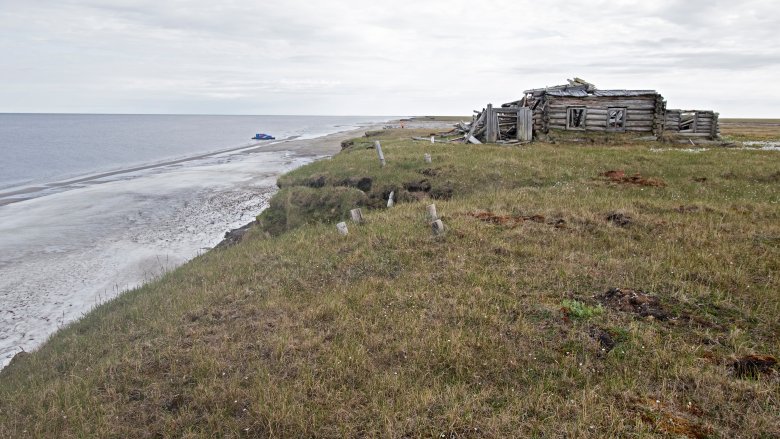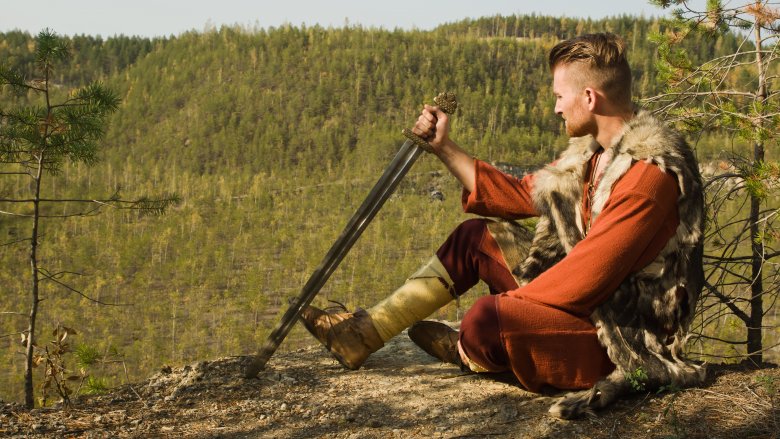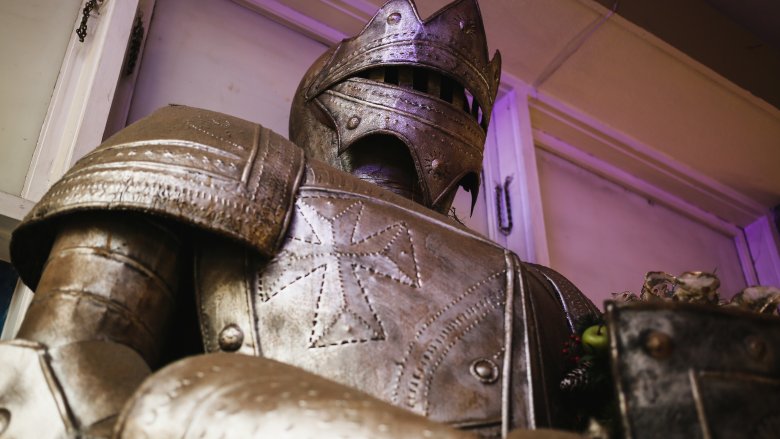The Strangest Places Man-Made Objects Have Been Found
When archaeologists dig up an Egyptian temple, they mostly expect to find it full of Egyptian stuff. When they excavate a thousand-year-old indigenous village in Alaska or an ancient campsite in northern Siberia, it's pretty much the same — they have a good idea what they're going to find, and they're not really prepared for surprises. But sometimes objects appear in strange places no one expects to find them, and that can leave archaeologists scrambling for an explanation or even just filing that find away as a mystery that may never be solved.
One day, we're quite sure, an archaeologist will discover an unusual cache of thousands of modern socks somewhere in remote Chile or perhaps an abandoned gold mine in the foothills of California, because all those stupid socks have to be going somewhere. But until that happens, we'll have to content ourselves with these non-sock objects that were found in pretty strange places.
Well, that hairpin is lost forever
Few things are equal to the horror of dropping something precious down the commode and then realizing you either have to stick your hand down there or lose the thing forever. Many a wedding ring has met with an untimely death among the poo and that weird blue chemical stuff, and as it turns out, toilet-related jewelry casualties don't just happen in modern bathrooms.
According to PRI, in 2012 archeologists were excavating a communal toilet at the Fontainebleau Palace outside Paris and almost certainly wondering, "How did four years of higher education lead to this?" when they discovered a 3.5-inch gold hairpin embedded in the ancient sewage. After scraping the 500-year-old poo off the artifact, they realized it wasn't just any poo-covered hairpin. It was a poo-covered hairpin that had once belonged to Catherine de Medici, queen of France from 1547 to 1559. The pin was identified by Catherine's signature interlocking "C" design and her official green and white colors.
What's odd about the find is that it was in a communal toilet, which was not the sort of toilet French queens were terribly fond of using. So it's possible that the pin had been stolen, and then later dropped down the toilet by some lady-in-waiting who either needed to ditch the evidence or got butterfingers at just the wrong moment.
The time-traveling hammer
If you Google "out of place objects," you'll find all sorts of stories of strange things found inside solid rock, like screws, spark plugs, and live frogs and toads. One of the most famous of these objects is The London Hammer, which was discovered in the mid-1930s by a couple in London, Texas, who decided a piece of wood sticking out of a rock was probably something that should be investigated. They took the rock home, busted it open, and found a hammer inside. The couple gave their find to archaeologists, who dated the rock to 100 million years, which seemed to suggest that the hammer was crafted long before human beings even existed.
If you're feeling a healthy dose of skepticism, you're not alone. According to Skeptoid, minerals from ancient strata could dissolve and then harden around whatever happens to have been left behind by a 19th-century carpenter who drank too much moonshine at lunchtime and staggered away without his hammer. So there's no reason to believe the hammer must be as old as the rock it was found in. Now, the debate could be fairly simply resolved if someone would just date, you know, the hammer's wood handle, but evidently either no one thought to do that or they were afraid that testing would lead to the hammer no longer being a big public draw at the Creation Evidence Museum of Texas, where it currently resides. Probably the latter.
Space junk on a hiking trail
How many kids have gazed up at the stars and wondered if a piece of space junk might accidentally hit them on the head? Yeah, becoming an astronaut sounds cool and all but falling space junk seems like a much more present possibility. And it actually is.
According to National Geographic, NASA once promised that space junk was not a threat because, the reasoning went, in all the years that had passed since humans first started putting things into orbit, no one has been killed or even injured by falling space junk. That we know of.
Never mind that 6,000 tons of man-made stuff has actually survived the fiery journey between orbit and Earth! The junk didn't hit anyone yet, so that means it never will. Well, there was that time in 1997 when some space junk brushed past the shoulder of a woman in Oklahoma, and that other time when some space junk missed demolishing a farmhouse in Texas by just a few feet. But still, there's no danger.
Anyway in March 2011 a hiker was hiking along, as hikers do, when he discovered a still-warm metal object sitting in a fresh crater. He called the military, who told him to call the sheriff, who told him to call NASA, and eventually the object, which turned out to be the tank from a Russian rocket, was recovered.
A boat out of water
One man-made object we know for sure simply does not belong in the Sahara Desert: A boat. Because why would anyone need a boat in the Sahara Desert? Answer: Because camels can't carry the dead to the afterlife. Something about their hooves not really being compatible with lakes of fire. According to Haaretz, in 2016, a 60-foot boat made of expensive, imported cedar was found buried in the sand in the ancient Egyptian city of Abusir. The boat is thought to be at least 4,500 years old.
What's weird about the find is not just that it's a freaking boat in the desert, but that a boat that size would normally be used for the funeral of a pharaoh or some other person of royal blood, and this boat just appears to have belonged to some dude. To be fair, he was a decently high-ranking official, but he wasn't of royal descent — which means he enjoyed remarkable status given his Some Dude origins.
Now we wouldn't be telling the whole truth if we didn't add that Abusir isn't exactly landlocked or anything. It's about 15 miles southwest of Cairo on the western bank of the Nile River. So although the boat was buried in the desert sands, in theory, someone probably could have drug it down to the river if they decided to use it as an actual boat instead of afterlife transportation. But that would have been silly.
A possibly useless bronze whatchamacallit
The bronze age began before 3000 B.C., but it was confined to Europe, Asia, and the Middle East. Indigenous people living in Arctic Alaska didn't make things out of bronze — and yet, the Anchorage Daily News says in 2016 a bronze age relic was found in the remains of a 1,000-year-old Inupiat dwelling.
The object appears to have been manufactured in a mold and was probably originally a buckle for a horse's harness, though the indigenous Alaskans didn't have any horses, either. Archaeologists dated an attached bit of leather to 900 A.D., though it's impossible to say if that particular piece of leather was added at the time of manufacture or much later.
The buckle was probably made in Asia, and the home's occupants may have obtained it either by traveling across the Bering Strait or trading with others who came across the Bering Strait. Which suggests there was commerce happening between Asia and the New World centuries before Columbus blundered into the Bahamas.
Without horses, though, what exactly did the Inupiat people want with a bronze harness buckle? No one really knows. Maybe they used it as a fastener for human clothing, or it could have been used by a shaman. Or maybe, just maybe, some ancient traveler/tradesman saw it and went, "Cool, I don't know what that's for but I want it." Or is that just an American thing?
A dice cup for White Walkers (or maybe for drinking)
Scientists were in Siberia monitoring permafrost when they found a fragment of a medieval bronze cup in an area where the permafrost is melting, near Lake Parisento, which is well within the Arctic Circle. So as you can see, melting permafrost is at least awesome from an archaeological standpoint, though it sucks for virtually every other imaginable reason.
According to the Siberian Times, the cup was probably manufactured in in the 10th or 11th century in modern-day Iran, roughly 2,300 miles away (if you send a raven) from where researchers found it.
So what was a bronze cup of Persian design doing in Siberia? Researchers only get to speculate, and at this point it's down to White Walkers playing dice or ancient traders who swapped them for things like walrus tusks and fur. This particular type of artifact is not the first to be found in Siberia, but it is the first of its kind to be found in the Siberian Arctic.
Archaeologists say Persian items were valued by the native people because they were believed to have spiritual or religious significance, so the cup was likely used to serve food to the gods, though that doesn't necessarily rule out White Walkers.
Poop-encased artwork
Because no list of things found in strange places would be complete without a pile of excrement, in 2017 researchers found a painting buried beneath roughly 118 years' worth of penguin poop.
The painting was found inside a hut that had been hidden for nearly a century beneath the accumulated poop of millions of flightless birds. The hut was once occupied by famed South Pole explorer Edward Wilson, who died on a 1912 expedition a couple months after reaching the South Pole.
According to The Guardian, the painting is a small watercolor of a dead bird entitled "Tree Creeper." It was found in a portfolio full of papers and some other totally boring stuff, and is one of around 1,500 separate artifacts found in the hut. Researchers used handwriting samples to identify the painting as Wilson's work.
Treecreepers are woodland birds found in the northern hemisphere, so Wilson probably didn't create the painting in Antarctica. It's unclear why he decided to bring it with him to Antarctica, but the cold, dark conditions of the Antarctic wilderness turned out to be ideal both for killing Antarctic explorers and for preserving light-sensitive watercolor paintings. And all that light-blocking penguin poop must have helped, too.
Mountaineering Vikings
Once upon a time, apparently, a Viking was walking around atop a mountain in southern Norway, probably so he could prove to other Vikings how badass he was, when he up and died. His remains vanished, but his sword stayed up there until a reindeer hunter found it more than 1,000 years later.
According to Fox, the sword was found at an elevation of 5,381 feet, which archaeologists think is an altitude record for Viking sword finding. The sword was sitting on the mountaintop out in the open on small, loose stones, which helped protect it from the sort of damage that might have occurred over time if it had been buried in soil. Conditions on top of the mountain are cold and dry, which also helped keep it in pristine condition.
This particular item wasn't uncovered by melting ice, but retreating glaciers often reveal artifacts in the area — some of those objects are around 6,000 years old. So it probably wasn't totally out of the ordinary for a Viking to be wandering around on a mountaintop, just sort of unnecessarily macho.
Buddha in a tree
Trees don't have hands, so they can't move stuff when it gets in their way. Which must be super annoying, especially since the lack of hands also means they can't Tweet-shame all the inconsiderate humans who leave their roller skates, bicycles, grenades, tombstones, and park benches right where they were planning on growing. Fortunately for trees, there's a very simple solution to the whole thing-in-the-way problem: just enveloping said thing, much like a creature from a bad horror movie only in ultra-slow motion and without any of the usual horrific screaming.
One of the strangest things-found-in-trees is the creepy Buddha head in Wat Mahathat in Thailand, which gazes out from its eternal tomb within the roots of a banyan tree. While some objects in trees are more head-scratchy than others, it's not a huge mystery how this particular head ended up in this particular tree. According to Thaizer, the Burmese army vandalized the 14th-century temple in 1767, and for some reason thought it would be awesome good fun to cut the heads off all the old statues.
After it was separated from its body, the head met up with the tree, and the tree grew around it in the most creepy and weird way possible, probably as a warning to humans not to leave their stuff sitting around at the base of a tree. Call it Twig-shaming, perhaps. Or the last frame of a Kiyoshi Kurosawa movie.
Shark-knight-oh!
Sharks are terrifying, but we all know they can't take down a dude in a suit of armor. Except for maybe this one time, in one of the weirdest "strange place" finds of all time.
Now, this story sounds completely fake but it's in Smithsonian Magazine, and those folks never lie. The story comes from a French physician named Guillaume Rondelet, who wasn't just some guy with a passing interest in sea monsters, but the author of Libri de Piscibus Marinis. Rondelet's book included scientific descriptions of hundreds of known sea creatures, including whales, seals, fish, and marine-dwelling invertebrates, and is regarded by many as the world's first work of ichthyology (the study of fish). So this was a pretty credible person.
In Libri de Piscibus Marinis, Rondelet describes a shark that was found with an entire suit of armor in its belly, which could have happened one of two ways: 1) The shark ate a dude wearing a suit of armor or 2) The dude took off his armor, put it on a raft while he was polishing his sword or being chivalrous or something, the raft floated away, the shark saw the suit of armor and figured it would make an easy meal, then ate the suit of armor, regretted it, and died. If there were ever a good use of a time machine...










